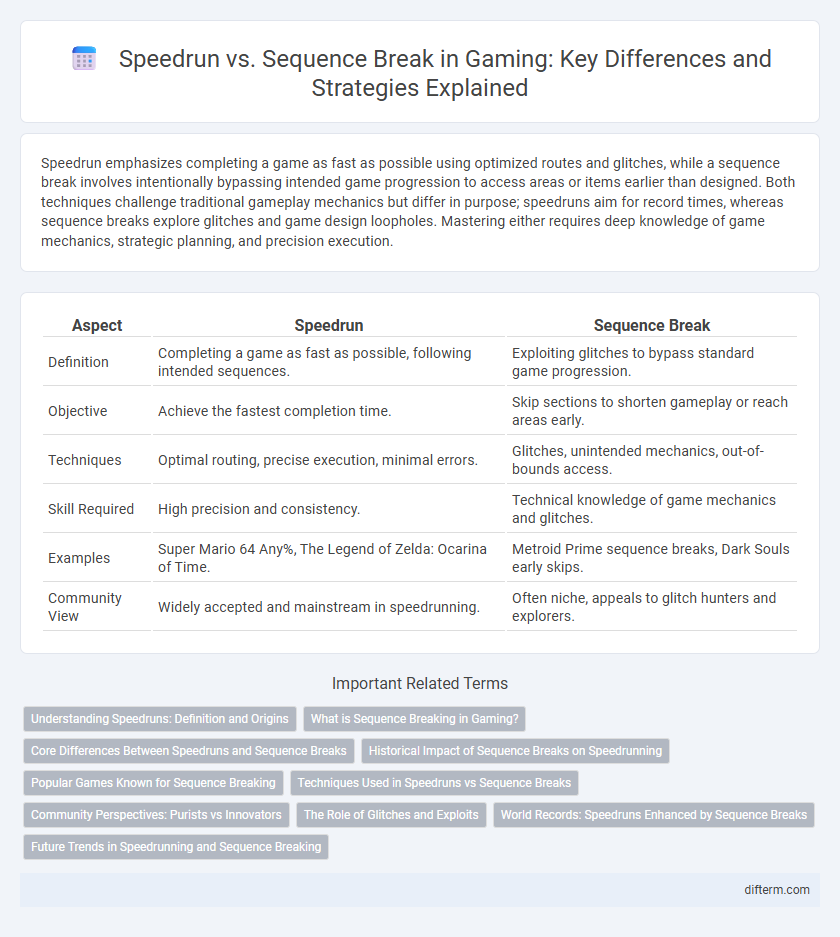Speedrun emphasizes completing a game as fast as possible using optimized routes and glitches, while a sequence break involves intentionally bypassing intended game progression to access areas or items earlier than designed. Both techniques challenge traditional gameplay mechanics but differ in purpose; speedruns aim for record times, whereas sequence breaks explore glitches and game design loopholes. Mastering either requires deep knowledge of game mechanics, strategic planning, and precision execution.
Table of Comparison
| Aspect | Speedrun | Sequence Break |
|---|---|---|
| Definition | Completing a game as fast as possible, following intended sequences. | Exploiting glitches to bypass standard game progression. |
| Objective | Achieve the fastest completion time. | Skip sections to shorten gameplay or reach areas early. |
| Techniques | Optimal routing, precise execution, minimal errors. | Glitches, unintended mechanics, out-of-bounds access. |
| Skill Required | High precision and consistency. | Technical knowledge of game mechanics and glitches. |
| Examples | Super Mario 64 Any%, The Legend of Zelda: Ocarina of Time. | Metroid Prime sequence breaks, Dark Souls early skips. |
| Community View | Widely accepted and mainstream in speedrunning. | Often niche, appeals to glitch hunters and explorers. |
Understanding Speedruns: Definition and Origins
Speedruns involve completing a video game or a specific level as quickly as possible, often exploiting optimized techniques and precise gameplay to achieve record times. Originating in the early 1990s within gaming communities like speedrun.com and forums such as Speed Demos Archive, speedrunning evolved through collaborative efforts to refine routes and strategies. This competitive practice emphasizes skill, knowledge of game mechanics, and sometimes the use of glitches distinct from sequence breaks, which specifically bypass required narrative segments or puzzles.
What is Sequence Breaking in Gaming?
Sequence breaking in gaming refers to the act of completing parts of a game in an unintended order, bypassing intended progression or prerequisites. This technique often allows players to access powerful items, skip difficult sections, or reach the endgame faster than designed. Speedrunners use sequence breaks strategically to shave time off completion records by exploiting glitches, shortcuts, or game design oversights.
Core Differences Between Speedruns and Sequence Breaks
Speedruns emphasize completing a game as quickly as possible, adhering to intended progression and utilizing optimal strategies to minimize time. Sequence breaks involve bypassing intended game order, accessing areas or items earlier than designed, often exploiting glitches or unintended mechanics. The core difference lies in speedruns prioritizing time efficiency within game rules, while sequence breaks focus on altering game sequence to gain advantages or discover new gameplay possibilities.
Historical Impact of Sequence Breaks on Speedrunning
Sequence breaks have significantly shaped the speedrunning community by enabling players to bypass intended game progressions, opening new strategies and routes. Early examples, such as the iconic wall clip in "Super Mario 64," revolutionized record possibilities and inspired extensive exploration of game mechanics. This historical evolution of sequence breaking has cemented its role as a foundational element in speedrunning innovation and competitive play.
Popular Games Known for Sequence Breaking
Popular games renowned for sequence breaking include "The Legend of Zelda: Ocarina of Time," "Super Metroid," and "Dark Souls," where players exploit glitches or unintended shortcuts to bypass standard progression. Speedrunners often combine sequence breaks to minimize completion times by accessing late-game areas or items earlier than intended. This strategic manipulation of game mechanics has cultivated dedicated communities that document and optimize these unconventional routes for record-setting runs.
Techniques Used in Speedruns vs Sequence Breaks
Speedrun techniques focus on optimizing game mechanics through precise inputs, frame-perfect timing, and exploiting glitches to complete levels as quickly as possible. Sequence breaks involve deliberately bypassing intended game progression by using glitches, unintended jumps, or item skips to access later areas early. Both methods require deep knowledge of game physics, but speedruns emphasize speed optimization while sequence breaks prioritize exploration of abnormal game sequences.
Community Perspectives: Purists vs Innovators
Speedrun communities often split between purists who value completing games as intended through defined rules, and innovators who embrace sequence breaks to discover new strategies and glitches. Purists prioritize skillful execution within established parameters, viewing sequence breaks as unfair advantages that diminish the game's intended challenge. Innovators celebrate creative problem-solving and game mechanics exploitation, fostering a dynamic culture that pushes the boundaries of traditional gameplay and speedrunning records.
The Role of Glitches and Exploits
Glitches and exploits play a crucial role in both speedrunning and sequence breaking by allowing players to bypass intended game mechanics and progress faster than normal. In speedrunning, these technical shortcuts minimize completion time and create new world record opportunities, while sequence breaks involve using the same techniques to access areas or items out of the intended order, altering the game's narrative flow. The mastery of specific glitches like clip through walls or item duplication significantly influences competitive leaderboards and shapes player strategies within these gaming communities.
World Records: Speedruns Enhanced by Sequence Breaks
World records in gaming often highlight the impact of sequence breaks, which allow players to bypass intended game progression, drastically reducing completion times in speedruns. Skilled speedrunners exploit these glitches and unintended shortcuts to achieve record-breaking times, as seen in titles like "The Legend of Zelda: Ocarina of Time" and "Super Mario 64." Sequence breaks not only redefine the boundaries of gameplay mechanics but also continuously push the limits of speedrun performances.
Future Trends in Speedrunning and Sequence Breaking
Future trends in speedrunning emphasize advanced tool-assisted techniques and artificial intelligence integration to optimize route strategies and minimize completion times. Sequence breaking is evolving with procedural generation and dynamic game worlds, allowing players to exploit novel glitches and non-linear pathways previously unexplored. Emerging communities leverage machine learning analytics to identify new exploits and refine speedrunning records, driving continuous innovation in gameplay efficiency.
Speedrun vs Sequence Break Infographic

 difterm.com
difterm.com